Archive:Agricultural output, price indices and income
- Data extracted in February 2017. Most recent data: Further Eurostat information, Main tables and Database. Planned article update: February 2018.
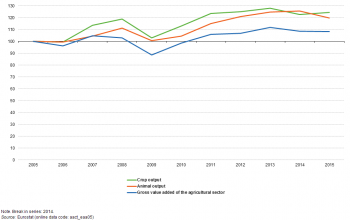
(2005 = 100)
Source: Eurostat (aact_eaa05)
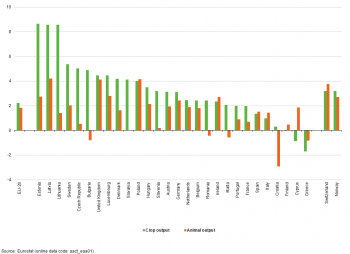
(average annual rate of change, %)
Source: Eurostat (aact_eaa01)
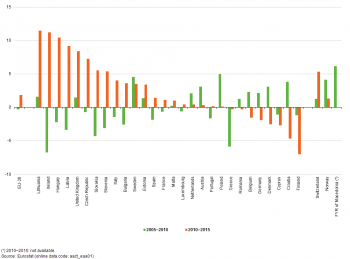
(average annual rate of change, %)
Source: Eurostat (aact_eaa01)

(%, share of value added)
Source: Eurostat (aact_eaa01)
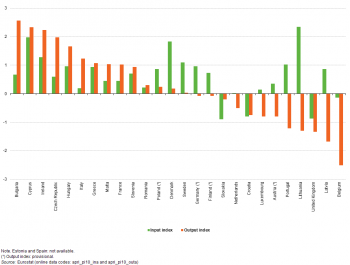
(average annual rate of change, %)
Source: Eurostat (apri_pi10_ina) and (apri_pi10_outa)
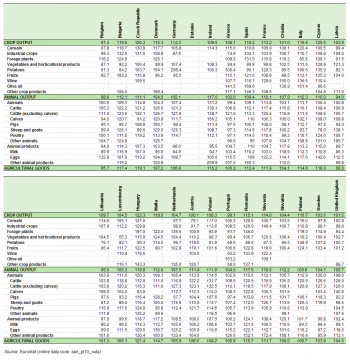
(2010 = 100)
Source: Eurostat (apri_pi10_outa)
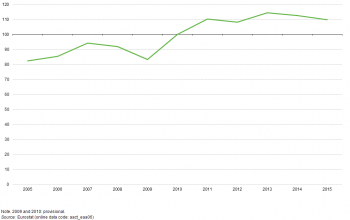
(2010 = 100)
Source: Eurostat (aact_eaa06)
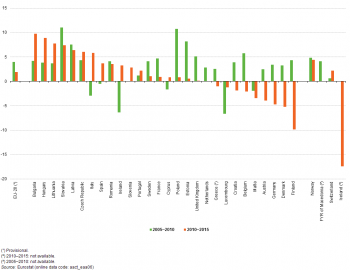
(average annual rate of change, %)
Source: Eurostat (aact_eaa06)
This article gives an overview of recent changes in agricultural output, gross value added and prices in the European Union (EU), and their effect on income from agricultural activity; the information presented is drawn from the economic accounts for agriculture (EAA).
One of the principal objectives of the common agricultural policy (CAP) is to provide farmers with a reasonable standard of living (while promoting more competitive and sustainable agriculture and encouraging vibrant rural areas). Although this concept is not defined explicitly within the CAP, a range of indicators including income development from farming activities may be used to determine the progress being made towards this objective.
Main statistical findings
Output and subsidies
The information presented in Figure 1 is in current price terms and at basic prices. It shows clearly a downturn in EU-28 agricultural output in 2009 (at the peak of the global financial and economic crisis) followed by an expansion through to 2012 or 2013 and then a generally downward pattern of developments until 2015.
The gross value of EU-28 crop output fell to a relative low of EUR 177.2 billion in 2009. This was followed by a rebound and four years of consecutive growth through to 2013 (peaking at EUR 220.1 billion). However, the latest information available reveals that crop output in the EU-28 fell by 4.1 % in 2014 to EUR 211.0 billion, before rallying (+1.5 %) in 2015, when output was valued at EUR 214.1 billion.
EU-28 gross animal output at basic prices also recorded a relative low in 2009 (EUR 138.0 billion), but then grew for five consecutive years to 2014. The rate of change slowed towards the end of this period and in 2014 there was almost no change (up 0.7 %) in the value of animal output in the EU-28, which reached EUR 172.4 billion. In 2015 there was a considerable fall in the animal output of the EU-28, which was valued at EUR 164.4 billion, some 4.6 % lower than the year before.
The increases in the EU-28’s gross output from 2009 to 2013 were offset to some extent by an increase in the value of intermediate consumption of goods and services at basic prices. Here too there was a period of relatively rapid growth between 2009 and 2012, followed by more modest growth in 2013 and then reductions of 0.8 % in 2014 and 1.5 % in 2015.
As a result, from a relative low of EUR 135.9 billion in 2009, the gross value added at basic prices of the EU-28’s agricultural sector rose for four consecutive years to reach a relative high of EUR 171.6 billion in 2013, before falling by 2.9 % to EUR 166.5 billion in 2014 and falling a further 0.5 % to EUR 165.7 billion in 2015.
Value added at basic prices — as presented in Figure 1 — includes the value of subsidies (less taxes) on products whereas value added at producer prices is the value before adding in any subsidies (less taxes) on products. For comparison, in 2015 the EU-28’s agricultural sector recorded value added at producer prices that was EUR 161.3 billion, 2.7 % lower than the valuation at basic prices. During the period from 2005 to 2015, average growth rates for crop output in producer prices stood at 2.9 % per annum, which was slightly higher than the change recorded for animal output (2.2 % per annum).
The majority of the EU Member States, 21 out of the 28, reported a higher rate of change for crop output than for animal output over the period under consideration (see Figure 2, which is shown for basic prices). The highest rates of change for crop output were recorded in the Baltic Member States, while the highest growth rates for animal output were recorded in Latvia, Poland and the United Kingdom. Romania, Malta, Bulgaria, Greece and Croatia were the only Member States to record a lower value of animal output in 2015 than in 2005, while there was no change in crop output in Finland and relatively small decreases in Cyprus and Greece.
Figure 3 shows the changes in gross value added at basic prices of the EU-28’s agricultural sector split between the periods 2005–2010 and 2010–2015 (expressed as average rates per annum). Comparing these two five-year periods, there was almost no change in value added developments in the EU-28’s agricultural sector between 2005 and 2010 (-0.3 % per annum), whereas growth averaged 1.9 % per annum during the second five-year period (2010–2015). Among the EU Member States there were contrasting patterns with 17 out of the 28 recording a higher average rate of change in 2010–2015 than during the period 2005–2010; 15 of the Member States reported a negative annual average rate of change in the first of these five-year periods and eight in the second, with Finland, Cyprus and Greece the only countries to record a negative rate in both periods.
As described above, the different valuations of value added reflect the relative importance of subsidies and to a lesser extent taxes; note the information presented on subsidies and taxes is also presented in current price terms. In 2015, subsidies (after deducting taxes) on products for the agricultural sector were valued at EUR 4.4 billion, while subsidies (less taxes) on production were nearly 10 times this level, at EUR 45.1 billion. Between 2005 and 2015 there was a considerable change in the various types of agricultural subsidies through successive reforms of the CAP: the shift from product to production subsidies was mainly implemented in 2005 and 2006. Product subsidies (less taxes) granted to the agricultural sector in the EU-28 in 2015 were 77.5 % lower than their value 10 years earlier, while the value of production subsidies (less taxes) was almost twice as high (82.8 % higher) between 2005 and 2015. Note that some of the EU Member States did not have any product subsides (less taxes) in 2005 and that as such an overall rate of change could not be computed (Bulgaria and Cyprus); in other Member States product subsidies (less taxes) completely disappeared during the period under consideration (the Czech Republic, Romania and Slovenia); in Ireland, the Netherlands and Austria, product subsidies less taxes changed form a positive to a negative value (thereby explaining their negative rate of change that was greater than 100 %); in Germany and Luxembourg, product subsidies (less taxes) were negative in both 2005 and 2015, with their level becoming larger over the 10 years under consideration.
It was common to find an increase in production subsidies (less taxes) during the period 2005 to 2015; however, the United Kingdom, Austria and Ireland each reported that their level of production subsidies (less taxes) fell, while there was no significant change recorded in Denmark. By contrast, the highest rates of change for production subsidies (less taxes) during the period 2005 to 2015 were recorded in the Netherlands, France and Bulgaria. In half of the EU Member States, production subsidies (less taxes) at least doubled in size during the period under consideration.
Whereas production subsidies (less taxes) were 10.2 times as high as product subsidies (less taxes) in 2015, they had only been 1.3 times as high in 2005. The net impact of these two types of subsidies (less taxes) in 2015 was to add an extra 29.9 % to value added at basic prices; for comparison, in 2005 the increase due to these two types of subsidies (less taxes) was 28.9 %.
Price indices
Changes in the value of agricultural output comprise a volume and price component. One important strand of recent changes in agricultural policy has been to move away from price support mechanisms, so that prices more accurately reflect market forces and changes in supply and demand. During the period 2010–2015 (see Figure 6) there were considerable differences between the EU Member States in the development of deflated agricultural output prices; such deflated prices show the extent to which agricultural prices have changed compared with consumer prices. Deflated output prices rose in 14 of the 26 Member States for which data are available (output price data are not available for Estonia and Spain) between 2010 and 2015, the largest increases being recorded for Bulgaria (average growth of 2.6 % per annum), Cyprus (2.3 % per annum), Ireland (2.2 % per annum) and the Czech Republic (2.0 % per annum); these were the only Member States where growth reached or exceeded 2.0 % per annum. By contrast, reductions were posted in 12 of the EU Member States, the largest being in Belgium (-2.5 % per annum) and Latvia (-1.7 % per annum).
The development of deflated agricultural input prices during the period 2010–2015 showed a somewhat different picture, as prices rose in all but four of the 26 EU Member States for which data are available (input price data are not available for Estonia and Spain). The exceptions were recorded in Belgium, Croatia, the United Kingdom and Slovakia, where input prices fell (with respect to consumer prices) by no more than 0.9 % per annum; all four of these Member States also recorded a decline for their deflated output price indices too. At the other end of the ranking, deflated input prices rose, on average, by 1.0–2.0 % per annum in Germany, Hungary, Portugal, Sweden, Ireland, Denmark and Cyprus, while the highest deflated input price increase was recorded in Lithuania, averaging 2.3 % per annum.
For 13 of the 26 EU Member States for which data are available, the average annual rate of change in deflated input prices was greater than the change in deflated output prices, with the largest differences (2.2–3.6 percentage points) observed for Portugal, Belgium, Latvia and Lithuania; each of these Member States recorded falling deflated output prices. Among the 13 EU Member States where deflated output price changes exceeded the change in deflated input prices the greatest differences (at least 1.0 percentage point) were observed for Italy, the Czech Republic and Bulgaria.
Table 1 presents provisional output price indices (nominal, not deflated) for a range of agricultural goods for 2015; the reference year for the index is 2010 (= 100); note there are no data available for Estonia. When analysed for the main components — crop output and animal output — there was a wide range of price developments across the EU Member States during the period 2010–2015. While crop output prices increased overall by 22.3 % in Hungary, 25.5 % in Cyprus and by 26.3 % in the Czech Republic during this five-year timespan, prices fell by 1.9 % in Portugal and by 8.6 % in Belgium; these were the only EU Member States where crop output prices fell during the period 2010–2015.
A similar comparison for animal output shows the highest price increases were recorded in Hungary (an overall increase of 19.8 %), followed by Romania (17.5 %) and Ireland (17.0 %). Animal output prices fell in three of the EU Member States during the period 2010–2015, with prices falling at their most rapid pace (by at least 5.0 % overall) in Latvia and Lithuania, while prices fell in Belgium by a smaller margin (falling 1.2 % overall). The upward development of animal output prices between 2010 and 2015 was, at least in part, influenced by pace of rising prices for eggs and cattle. Some of the highest price increases for crop output were recorded for olive oil and wine.
Income: Indicator A
The real net value added at factor cost of agricultural activity per unit of labour (expressed in annual work units), also known as the agricultural income indicator A, fell in the EU-28 during 2008 and 2009, but recovered the following year and continued to grow rapidly in 2011. During the period 2011–2015 the EU-28 level of agricultural income remained relatively unchanged, with growth of 5.7 % in 2013 being cancelled out by contractions of 1.9 %, 1.7 % and 2.3 % in 2012, 2014 and 2015. Agricultural income (measured on the basis of indicator A) was 33.6 % higher in 2015 than it had been in 2005 (see Figure 7). An analysis over time shows that EU-28 agricultural income rose, on average by 4.0 % per annum between 2005 and 2010, while the rate of change for agricultural income slowed thereafter, rising on average by 1.9 % per annum between 2010 and 2015.
There were stark contrasts among the EU Member States in the development of this indicator (see Figure 8). There were 11 Member States where the index of income from agricultural activity rose at a faster pace between 2010 and 2015 than it had between 2005 and 2010; the vast majority of these were eastern or southern Member States, but the list also included Lithuania, Luxembourg and Ireland. The highest average growth rates between 2010 and 2015 were recorded in Lithuania (7.7 % per annum), Hungary (8.9 % per annum) and Bulgaria (9.7 % per annum). By contrast, there were nine Member States where agricultural income fell during the period 2010–2015. The biggest reductions in income were recorded for Germany (-4.7 % per annum), Denmark (-5.2 % per annum) and Finland (-9.9 % per annum).
Data sources and availability
Economic accounts for agriculture (EAA) provide an insight into:
- the economic viability of agriculture;
- agriculture’s contribution to each EU Member State’s wealth;
- the structure and composition of agricultural production and inputs;
- the remuneration of factors of production;
- relationships between prices and quantities of both inputs and outputs.
These accounts comprise a production account, a generation of income account, an entrepreneurial income account and some elements of a capital account. For the production items, EU Member States transmit to Eurostat values at basic prices, as well as their components (values at producer prices, subsidies on products, and taxes on products). The data for the production account and for gross fixed capital formation are transmitted in both current prices and the prices of the previous year.
The output of agricultural activity includes output sold (including trade in agricultural goods and services between agricultural units), changes in stocks, output for own final use (own final consumption and own-account gross fixed capital formation), output produced for further processing by agricultural producers, as well as intra-unit consumption of livestock feed products. The output of the agricultural sector is made up of the sum of the output of agricultural products and of the goods and services produced in inseparable non-agricultural secondary activities; animal output and crop output are the main product categories of agricultural output.
Gross value added equals the value of output less the value of intermediate consumption. Intermediate consumption represents the value of all goods and services used as inputs in the production process, excluding fixed assets whose consumption is recorded as fixed capital consumption. The EU Member States transmit information on intermediate consumption to Eurostat using values at purchaser prices (basic prices).
Eurostat also collects annual agricultural prices (in principle net of VAT) to compare agricultural price levels between EU Member States and to study sales channels. Quarterly and annual price indices for agricultural products and the means of agricultural production, on the other hand, are used principally to analyse price developments and their effect on agricultural income. Agricultural price indices are obtained by a base-weighted Laspeyres calculation (2010 = 100), and are expressed in nominal terms or as deflated indices based on the use of an implicit harmonised index of consumer prices (HICP) deflator
Agricultural income indicators are presented in the form of:
- an index of real income of factors in agricultural activity per annual work unit (indicator A);
- an index of real net agricultural entrepreneurial income, per unpaid annual work unit (indicator B);
- and the net entrepreneurial income of agriculture (indicator C).
The information presented in this article for indicator A (as found in Figure 7 and Figure 8) relates to constant 2005 prices (2010 = 100).
Context
Significant reforms of the common agricultural policy (CAP) have taken place in recent years, most notably in 2003, 2008 and 2013, with the aim of making the agricultural sector more market-oriented. The 2003 reform introduced a new system of direct payments, known as the single payment scheme, under which aid was no longer linked to the level of production (decoupling); this single payment scheme aimed to guarantee farmers more stable incomes. Farmers could decide what to produce in the knowledge that they would receive the same amount of aid, allowing them to adjust production to suit demand. In 2008, further changes were made to the CAP, building on the reform package from 2003.
The Europe 2020 strategy offers a new perspective on economic, social, environmental, climate-related and technological challenges and future agricultural reform is likely to be made in relation to the goals of developing intelligent, sustainable and inclusive growth, while taking account of the wealth and diversity of the agricultural sector within the EU Member States. As part of this process, the European Commission launched a public debate on the future of the CAP during 2010. Its outcome, coupled with input from the European Council and Parliament led the European Commission to present a Communication in November 2010, titled ‘The CAP towards 2020: meeting the food, natural resources and territorial challenges of the future’ (COM(2010) 672 final).
In December 2013, this latest reform of the CAP was formally adopted by the European Parliament and the Council. Among the main elements of the CAP post-2013 are a fairer distribution of direct payments (with targeted support and convergence goals), revisions to public intervention and private storage aid, and continued support for rural development.
See also
Further Eurostat information
Publications
- Agriculture, forestry and fishery statistics — 2016 edition
- Agriculture, forestry and fishery statistics — 2015 edition
- EU agricultural income per annual work unit in EU-27 remained at the same level in 2012 — Statistics in focus 19/2013
Main tables
- Agriculture (t_agri), see:
- Economic Accounts for Agriculture (t_aact)
- Crop output - basic and producer prices (tag00054)
- Animal output - basic and producer prices (tag00055)
- Output of the agricultural industry - basic and producer prices (tag00102)
- Gross value added of the agricultural industry - basic and producer prices (tag00056)
- Indicator A of the income from agricultural activity (tag00057)
- Agricultural prices and price indices (t_apri)
Database
- Agriculture (agri), see:
- Economic Accounts for Agriculture (aact)
- Economic Accounts for Agriculture (aact_eaa)
- Agricultural Labour Input Statistics (aact_ali)
- Agricultural prices and price indices (apri)
- Selling prices of agricultural products (absolute prices), land prices and rents (apri_ap)
- Price indices of agricultural products (apri_pi)
Dedicated section
Methodology / Metadata
- Absolute agricultural prices (ESMS metadata file — apri_ap_esms)
- Economic accounts for agriculture (ESMS metadata file — aact_esms)
- Price indices of agricultural products (ESMS metadata file — apri_pi_esms)
Source data for tables and figures (MS Excel)
Other information
- Handbook for EU agricultural price statistics (PDF)
- Regulation (EC) No 138/2004 on the economic accounts for agriculture in the Community
External links
- European Commission — Agriculture and Rural Development — Agricultural markets and prices
- Food and Agriculture Organisation of the United Nations (FAO) — Statistics
